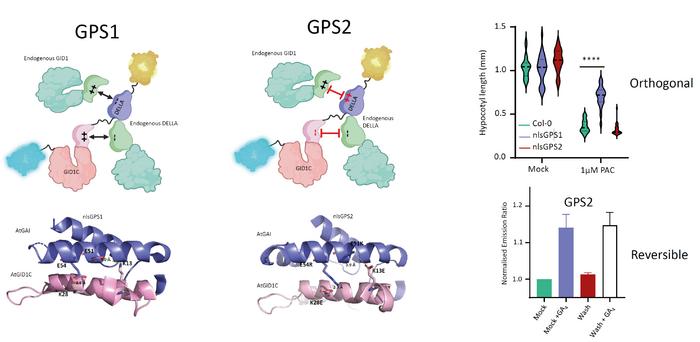Advancements in biosensor technology are now letting us observe previously undetectable plant hormones orchestrating growth and responding to environmental stimuli in real-time within living plants.

Credit: Alexander Jones research group, Sainsbury Laboratory, University of Cambridge
Advancements in biosensor technology are now letting us observe previously undetectable plant hormones orchestrating growth and responding to environmental stimuli in real-time within living plants.
New research from the University of Cambridge team behind this technology explains how the plant hormone gibberellin (GA) interacts with other signals to make changes in plant stem growth and has unveiled previously hidden hormone patterns triggered in the transition from dark to light.
Plant hormones underpin all aspects of plant development, enabling plants to adapt dynamically to changing environments.
This remarkable ability of plants to modify their growth and development in response to various environmental stimuli is known as plant plasticity. Understanding plant plasticity and how plants adapt to survive and optimise their growth is important for informing agricultural practices and improving crop resilience in changeable environments.
GA is a plant growth hormone that plays an essential role right from the start of a plant’s life. Shortly after germinating in the dark, GA stimulates rapid elongation of the hypocotyl (the stem of a germinating seedling), enabling the seedling to quickly emerge from the soil and reach sunlight.
In research published in The Plant Cell, Dr Alexander Jones team at the Sainsbury Laboratory Cambridge University (SLCU) has shown it’s not simply GA levels, but complex signalling to produce GA gradients required for plants to dynamically control their growth and respond to their environment.
Big complexity in a tiny plant
Studying the early-stage growth of Arabidopsis thaliana seedlings, the team has revealed a complex signalling happening in the growth and development in even a small plant.
Using a highly sensitive GA biosensor called Gibberellin Perception Sensor 1 (GPS1), engineered first in the lab of Wolf Frommer at Carnegie Institution for Science and then at Sainsbury Laboratory Cambridge University (SLCU), the Jones team previously tracked and quantified GA level changes at the single cell level in different zones of rapidly growing seedlings, including in the root zone.
Their latest research focused on the hypocotyl and the signalling controlling its rapid growth and uncurling of the apical hook.
“In the dark, gibberellin levels are typically higher and you can see that the longer cells have more GA than the smaller cells, with some exceptions,” said Dr Jayne Griffiths, first-author of the research and researcher in the Jones Group.
“There is a beautiful positive correlation between GA and cell length as visualised by the biosensor, but when we add more GA we don’t see an increase in cell length. This indicates that the GA gradient that we see in the hypocotyl is necessary for cell elongation, but it is not sufficient.
“On further investigation, we identified that GA20ox1 is the rate limiting enzyme setting GA levels hypocotyl cells and is responsible for producing the GA gradient we see in darkness. We found this enzyme is tightly controlled by COP1, a critical regulator that programs development in darkness, and that COP1 is crucial for the GA gradient in darkness.”
This indicates that the plant dark signaling is boosting GA in specific cells and GA in turns boosts dark signaling and rapid cell growth.
But how does the plant dynamically change its growth pattern?
Let there be light
Once exposed to light, the hypocotyl’s rapid growth pattern shifts, developing shorter, sturdier stems to support the formation of branches and leaves.
Is the plant lowering GA or moving it to different parts of the plant?
To see what is happening with GA during this transition from dark to light, a new biosensor was needed because GPS1 was not reversible and not able to record decreasing concentrations of GA.
A new reversible biosensor, GIBBERELLIN PERCEPTION SENSOR 2 (GPS2), with enhanced capabilities was engineered by the Jones team. “GPS2 unveiled a previously hidden pattern of GA depletion during light-induced growth transitions, explaining the changes that we see in hypocotyl growth,” Dr Jones said. “This new biosensor offers valuable insights into how GA distributions connect environmental conditions with plant morphology and plasticity. We envisage major new insights to come from being able to achieve cell-level resolution of GA dynamics in plant development and understanding the underlying cellular dynamics in other developmental stages such as budbreak, branching and flowering.”
Benefits of understanding gibberellin
Although they did not know it at the time, the high-yielding semi-dwarf crops selected for in the Green Revolution of the 1960s carried genes that either reduced GA biosynthesis or made the plant less responsive to GA. But broad lowering of GA negatively affected other traits.
In an ideal world, we want to be able to control GA levels in specific parts of a plant to produce the traits we want – lower GA for shorter stem length and higher GA for bigger grains and more efficient use of nitrogen fertiliser.
Dr Jones added: “Understanding the mechanisms behind plant developmental control can help us to help plants make smart growth decisions to suit their environment or the field environment that you put them in. When to grow, how much to grow and where to grow. These questions are often cell-based or sub-cellular even and by predicting hormones at a much finer scale we can target phenotypes we want and avoid off-target effects.”
Reference
Jayne Griffiths, Annalisa Rizza, Bijun Tang, Wolf B Frommer and Alexander M Jones (2024) GIBBERELLIN PERCEPTION SENSOR 2 reveals genesis and role of cellular GA dynamics in light-regulated hypocotyl growth. Plant Cell.
DOI: https://doi.org/10.1093/plcell/koae198
Funding
This work was supported by the Gatsby Charitable Foundation and European Research Council.
Journal
The Plant Cell
DOI
10.1093/plcell/koae198
Method of Research
Experimental study
Subject of Research
Cells
Article Title
GIBBERELLIN PERCEPTION SENSOR 2 reveals genesis and role of cellular GA dynamics in light-regulated hypocotyl growth
Article Publication Date
22-Jul-2024
COI Statement
The authors declare no competing interests.




